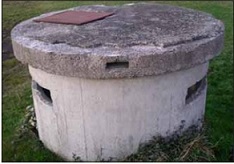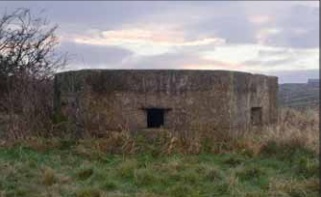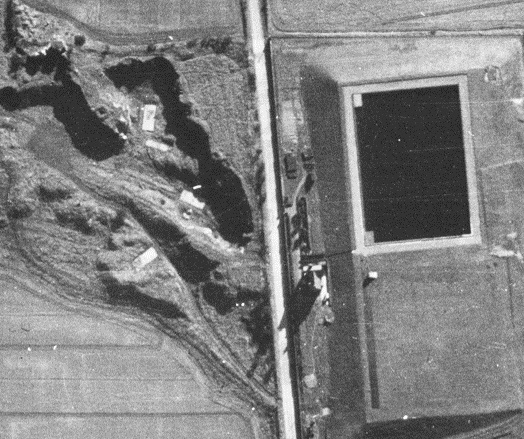

Pickett Hamilton Forts
 These forts were a type of pillbox unique to airfields, and were often placed down the very centre of the runway. The design involved a short concrete cylinder with firing holes or ‘embrasures’ in the side. This cylinder could be raised or lowered by a pneumatic jack so that in normal conditions the pillbox roof would lie completely flush with the ground, allowing easy take off and landing for aircraft. Should the airfield be attacked, the jack would raise up the pillbox by 2 ft in just fifteen seconds, allowing a two man crew to man the post, and fire out of the embrasures. The fort itself would also act as a physical obstruction, preventing any enemy aircraft from landing on the runway (Lowry 1996, 124). The design for these pillboxes was first registered in June 1940, and by the end of the year three had been installed at Usworth. One can still be seen at the former site of RAF Usworth, resited from the runway, standing on a grass verge just inside the gates of the North East Aircraft Museum (Lowry 1996).
These forts were a type of pillbox unique to airfields, and were often placed down the very centre of the runway. The design involved a short concrete cylinder with firing holes or ‘embrasures’ in the side. This cylinder could be raised or lowered by a pneumatic jack so that in normal conditions the pillbox roof would lie completely flush with the ground, allowing easy take off and landing for aircraft. Should the airfield be attacked, the jack would raise up the pillbox by 2 ft in just fifteen seconds, allowing a two man crew to man the post, and fire out of the embrasures. The fort itself would also act as a physical obstruction, preventing any enemy aircraft from landing on the runway (Lowry 1996, 124). The design for these pillboxes was first registered in June 1940, and by the end of the year three had been installed at Usworth. One can still be seen at the former site of RAF Usworth, resited from the runway, standing on a grass verge just inside the gates of the North East Aircraft Museum (Lowry 1996).
PillBoxes
 Pillboxes are sometimes referred to as defence posts, blockhouses or police posts. Concrete pillboxes were first used by the Russians in the Russo-Japanese War. The idea was copied by the Germans in World War One and later by the British. Some pillboxes were sited to defend coastal batteries, airfields, radar stations and factories, others were part of stop lines. More than 18,000 were built during 1940. There were a dozen standard pillbox designs, but in fact many more designs were used. The Defence of Britain Handbook describes them as “a basic squat, heavily constructed building, usually flat-roofed, no more than 1.98m high and quadrilateral, polygonal or circular in plan. There were one or two entrances, sometimes protected by a porch or wall. They all have a series of horizontal slits (firing loops, loopholes or embrasures) to provide interlocking fields of fire over the anticipated direction of attack”. Most pillboxes were designed for rifles or light machine guns. More heavily armed examples had Vickers machine guns, antitank guns or Hotchkiss guns. Pillbox walls are almost always of concrete, sometimes with brick shuttering or stone facing (Lowry 1996, 79-82). The threat of an invasion was lessened in 1941 when Hitler invaded the Soviet Union. No more pillboxes were built after February 1942.
Pillboxes are sometimes referred to as defence posts, blockhouses or police posts. Concrete pillboxes were first used by the Russians in the Russo-Japanese War. The idea was copied by the Germans in World War One and later by the British. Some pillboxes were sited to defend coastal batteries, airfields, radar stations and factories, others were part of stop lines. More than 18,000 were built during 1940. There were a dozen standard pillbox designs, but in fact many more designs were used. The Defence of Britain Handbook describes them as “a basic squat, heavily constructed building, usually flat-roofed, no more than 1.98m high and quadrilateral, polygonal or circular in plan. There were one or two entrances, sometimes protected by a porch or wall. They all have a series of horizontal slits (firing loops, loopholes or embrasures) to provide interlocking fields of fire over the anticipated direction of attack”. Most pillboxes were designed for rifles or light machine guns. More heavily armed examples had Vickers machine guns, antitank guns or Hotchkiss guns. Pillbox walls are almost always of concrete, sometimes with brick shuttering or stone facing (Lowry 1996, 79-82). The threat of an invasion was lessened in 1941 when Hitler invaded the Soviet Union. No more pillboxes were built after February 1942.
Boldon (HER 5380)Grid Reference:NZ353601
 This Picture taken from an RAF photograph in 1946 (Reproduced by permission of Historic England Archive) shows a number of concrete type structures across the road from the resevoir. As in the Italian POW camp elsewhere in Boldon they have used the natural features of the land as extra defences by using old quarry workings to locate the Gun's its proximaty to the road providing an ideal checkpoint for those traveliing from the Hylton direction.
This Picture taken from an RAF photograph in 1946 (Reproduced by permission of Historic England Archive) shows a number of concrete type structures across the road from the resevoir. As in the Italian POW camp elsewhere in Boldon they have used the natural features of the land as extra defences by using old quarry workings to locate the Gun's its proximaty to the road providing an ideal checkpoint for those traveliing from the Hylton direction.
This location is the top end of the golf course near hylton Road so would have had a good view of the sea and today still lies undeveloped scrub land on the edge of the course, whether or not any evidence of its previous use can be found under the scrub is unknown other than maybe some foundations but nothing is immediately evident from the road side.
This is on the opposite side of the road where the resevoir is located. Same one? or one to watch the road and one to watch the sea?
Grid Reference:NZ354606